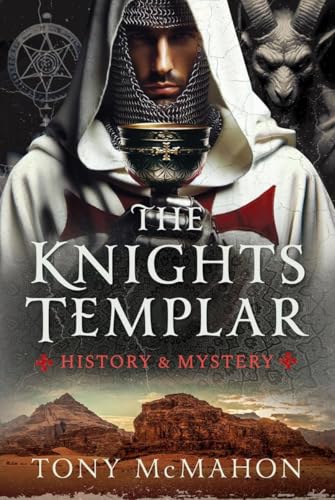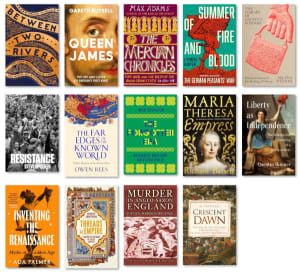It is a curious fact that there have been more books written about the Knights Templar than the number of Knights Templar that ever existed.1
The Knights Templar: History and Mystery by Tony McMahon is another worthy addition to this sub-genre.
I think most people will have an idea of who the Knights Templar were, but for those who don’t here is my very brief summary, using what I have learned from this book:
Templar Primer
When a small Western European army, fired up by religious zeal and egged on by the Pope, miraculously conquered Jerusalem and other nearby territories in the first crusade of 1099, it wasn’t long before Western Christian pilgrim visitor numbers started ticking up.
The newly formed crusader states were still a frontier zone and these religious tourists frequently found themselves getting fleeced or worse by hostile armed bands.
The Knights Templar were formed in 1118 or 1119 with the mission of protecting the pilgrims.
What made them different from standard policemen was their insistence on dedicating their entire existence to the force: communal living, regular prayer, mandatory celibacy and unquestioning obedience to the grand master of the order.
In fact the only authority that the Knights Templar were bound to obey apart from their own Grand Master was the Pope - they didn’t even have to pay taxes. As they developed into an expert military force, with estates in the Western Europe and a large scale international banking operation, medieval Kings became increasingly reliant on them but could become jealous and resentful too.
They were crucially weakened in 1291 when they were forced out of the holy land to the island of Cyprus, a consequence of the crusader states being finally overrun and defeated by the Mamluks of Egypt. The Knights Templars’ were consistently heroic on the battlefield but frequently ended up dead as a result. Out of the 23 Grand Masters in the organisation’s history, 6 were killed fighting.
Meanwhile king Philip IV of France was running out of cash and the Knights Templar were a tempting target. On 13 October 1307 all Templar personnel and their assets were seized. Facing absurd charges of diabolism, heresy and institutional sodomy, the last Grand Master Jacques de Molay, and 54 of his knights were burned alive in Paris.
The rest were let out of jail years later, tortured and broken and the Pope, under extreme pressure from King Philip IV of France, wound up the order.
And that was the end of that - since then the Knights Templar have lived on in our imaginations only, but have been associated with all sorts of barmy ideas about hidden treasure (sometimes magical), the (non existent) descendants of Jesus and a bizarre fixation with the Merovingian kings of France.
The hidden truth?
I have to admit that when I started The Knights Templar I was worried it was going to go full Hancock2. Reading sections in the introduction such as “Could the Templars have come to believe that he [John the Baptist], and not Jesus, was the true Messiah?” and “All of which paints a picture of an order of knights that started life as faithful sons of the Roman Catholic church but end up riddled with heresies” made me fear it was going to veer into conspiracy theory territory.
But actually - and for me, thankfully - this book is a fairly standard narrative history of the Crusades, with the story of the Templars woven in.
Mahon breezily takes us through the two centuries of the Templars' existence, outlining the key events in the Middle East without getting bogged down in the details.
While the author does mention some of the people who have in modern times created new legends about the Templars - whose ideas were distilled into the preposterous (and preposterously popular) Da Vinci Code - these are always as an aside before we return to the reality of who the Knights actually were, rather than what other people have wanted them to be.
Bankers and fighters
As well as the narrative of the Crusader States, there is also a chapter on the ‘home front’, detailing the organisation of Templars’ estates and business dealings in Western Europe - the result of donations and bequests from royalty and wealthy aristocrats.
One element that made them relatively unusual in the middle ages was their financial services arm. Because they operated across borders, owned highly secure castles and other strongholds and had excellent connections along the nobility they were ideally placed to offer:
- 🏰 safety deposit boxes: store your valuables with us when off on crusade;
- 💸 international money transfers: deposit in England withdraw in the Holy Land;
- 💰lending services: ready cash to fund your trip.
For me they were among the most interesting parts, possibly because I work in financial services myself!
Any downsides?
Overall this book is a nice historical summary of the Knights Templar. But whether or not it is one of the best books on the Templars I am not really qualified to judge, having not read any others.
Equally, if you have read loads of other books on the topic I suspect you won’t find much new here - the history being offered is a retelling of the accepted story rather than a bold new angle.3
What I liked best
What I most appreciated about the book is the way that it introduces you to a varied cast of fascinating elite characters, giving you a feel for (some of) the people of the time - but not to the extent that you lose track of what is going on. In short, the level of detail is just right.
Conclusion
A solid retelling of the Knights Templar story. While it covers some of the conspiracy theories that have built up around the knights in modern times, it stays on the right side of the crazy line, keeping us on track with who they were, what they did and why they were different.
And following the tradition of many of those books, I do not feel under any obligation to justify the veracity of that statement. ↩︎
As in Graham Hancock who has written The Handbag of the Gods and other bestsellers and is best known for his insinuations that the Great Pyramid in Egypt was constructed with extra terrestrial help. ↩︎
There is however a curious little anecdote in the book that was new to me, related to the death of Richard I, King of England / Lionheart. Richard was killed by a crossbow bolt to the shoulder when the wound became infected. McMahon also reports: “The crossbowman, a boy, was captured and Richard forgave him. But on the king’s death, the boy was flayed alive.” I will try to track down the origin of this story later! ↩︎
Book details
(back to top)- Title -
The Knights Templar : History & Mystery
- Author -
Tony McMahon
- Publication date -
November 2024
- Publisher -
Pen and Sword History
- Pages -
232
- ISBN 13 -
9781036113483
- Amazon UK -
- Amazon US -



